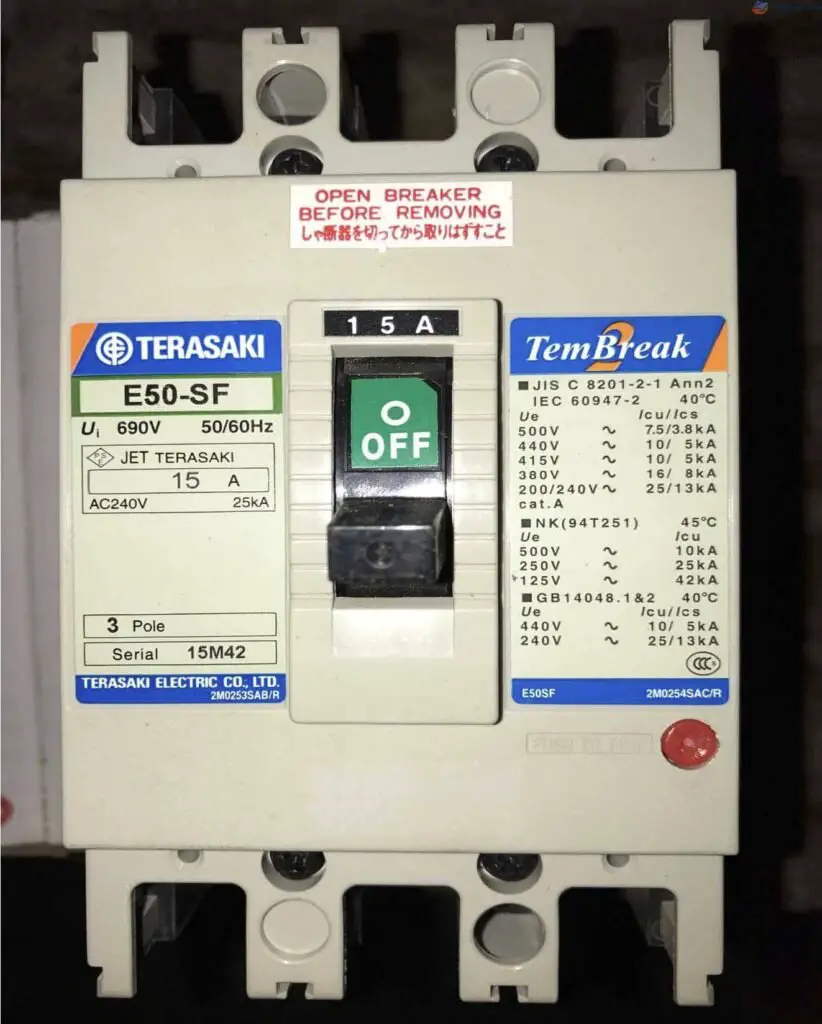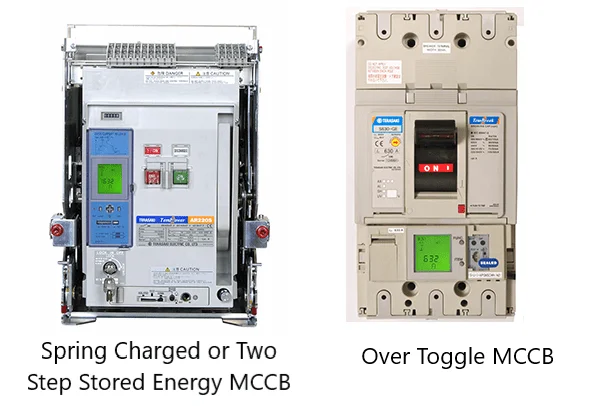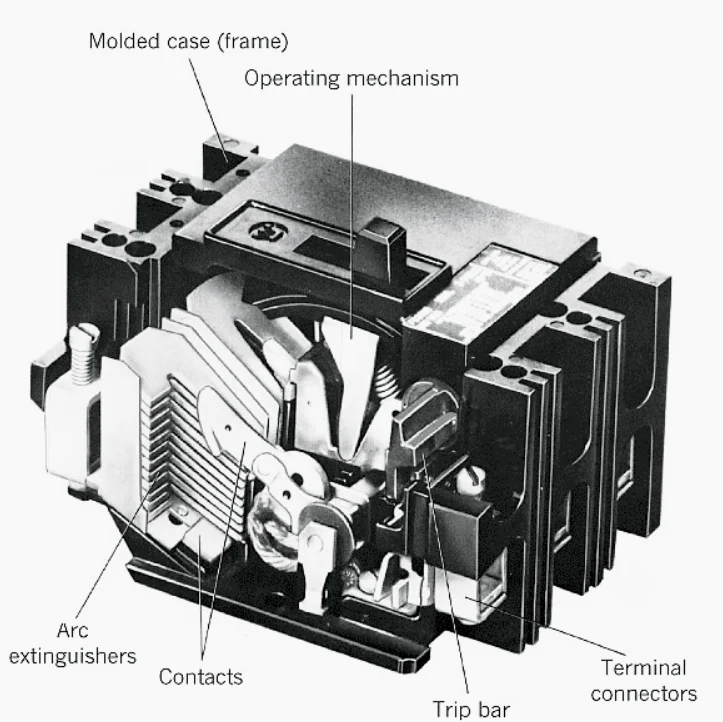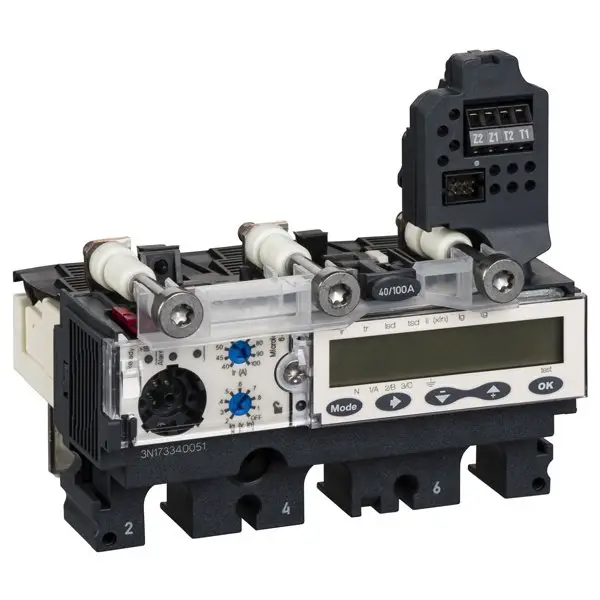An MCCB or Molded Case Circuit Breaker is a modular device used to protect a piece of low voltage equipment or circuit from overload and short circuits. Apart from overloads and short circuits, specially designed MCCBs can protect against ground faults or residual currents. They can be used for power distribution, motor protection, and as isolators for lines/busbars and industrial loads. They are available from 15A to 2500A and have a maximum short circuit withstand capacity of 150kA.
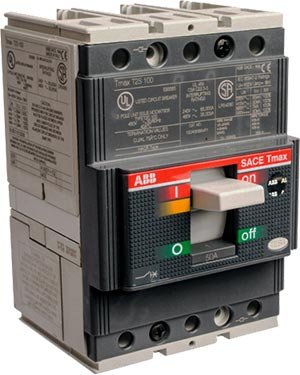
Moulded case circuit breakers – MCCB
MCCBs are mounted in a switchgear assembly and are most commonly used in low voltage power distribution boards. A molded case circuit breaker is made by assembling tripping mechanisms, arc chutes, and contact terminals within a molded case. The molded case helps the breaker to achieve a high dielectric as well as mechanical strength.
Parts and construction of an MCCB
The following are the parts of a molded case circuit breaker:
- Moulded case or the breaker frame.
- Operating mechanism
- Arc chutes or arc extinguishers
- Contacts and terminals
- Trip units
Moulded case or Breaker frame
The operating mechanism and arc extinguisher must be held rigidly during the operation in order to successfully interrupt the fault current. In addition, these parts need to be protected from the external environment. The case or frame is made up of strong insulation materials such as glass-polyester or thermoset composite resins. Metal frames may also be used.
Operating Mechanism
The function of an operating mechanism is to enable open/close operation in a circuit breaker. The operating mechanism is attached to the movable contacts present inside the breaker. They enable quick and safe opening and closing of circuit breakers. In MCCBs rated below 630A, over-toggle mechanisms are preferred. External operation handles can be fitted to these if required. For those rated over 630A spring charged operating mechanisms are used.
In spring charged operating mechanisms have a closing spring and an opening spring. The closing spring needs to be changed fully before closing the circuit breaker to ensure rapid closing action. The closing spring can be charged with the help of an electric motor fitted within the casing or via a charging handle.
Arc chutes or arc extinguishers
The primary function of arc chutes is to divide, cool, and safely extinguish an electric arc. Read more about arc chutes here: What is an arc chute?

Contacts and terminals
An MCCB has a set of moving contact and another set of stationary contacts which are connected to the terminal contacts. These two sets of contacts are surrounded by the arc chutes. The moving contacts are attached to the operating mechanism. The incoming and outgoing cables can be connected to the terminal connectors.
Trip units
The trip unit is the part that senses various fault conditions. On the detection of faults, it trips or opens the circuit breaker. The trip units can be an electro-mechanical type or electronic type (Solid State). The electro-mechanical trip unit utilizes bimetallic strips to sense the faults. These can sense overloads and short circuit conditions only.
The trip currents can be adjusted from the trip unit in order to achieve much precise protection.
The protection functionality of Electronic Trip Units includes Earth fault protection, overvoltage, and under-voltage protection, phase reversal and phase loss protection, residual current protection, overtemperature protection, over/under frequency protection, and power reversal protection. It is not mandatory for an MCCB trip unit to have all these protection functionalities built in. It is necessary to select the appropriate trip unit that fulfills your requirement.
The electronic trip units are micro-controller-based. They are highly versatile and configurable. It has a wide range of protection functions. Some of them have inbuilt communication capability that makes it possible to transfer real-time data to SCADA or DCS systems. Trip units are interchangeable and can be selected based on the protection function required.
Working principle of an MCCB
The contacts can be opened or closed using the operating handle or the motorized mechanism. When opened or closed it latches to the position until the trip bar is triggered or its position is changed manually.
Electromagnetic trip type:
As described earlier electromagnetic trip type MCCBs have bimetallic strips in them. On the flow of excessive current, the bimetallic strip deforms and strikes the trip bar. The trip bar opens the latch that holds the moving contacts and the circuit breaker trips.
Electronic trip type:
The current flow through the circuit breaker is monitored continuously by a microcontroller using current transformers. Current transformers sense the magnitude of current flowing through each phase of the MCCB. Depending on the magnitude of the current flow, the electronic trip unit triggers the trip bar if any of the following conditions are met:
- The current exceeds the set rated current for a particular period of time as defined by the trip curve of the breaker.
- If the current exceeds the set instantaneous current trip limit.
Apart from the above mentioned, there are several other conditions such as neutral faults, ground faults, residual currents, inverse time overcurrent, and definite time overcurrents during which the trip units mechanically trip the MCCB.
Electronic trip units are more sophisticated when compared to electromagnetic trip units. The trip characteristics can be adjusted from the trip unit. This makes them more flexible and versatile when compared to other circuit protection devices.
Protection functions of MCCBs
The following are the basic protection functions of a molded case circuit breaker:
- Overload Protection.
- Short circuit protection.
Apart from these two protections, the following protective features can also be possible with trip units:
- Earth fault protection.
- Time delayed overcurrent protection.
- Inverse current protection.
- Neutral current protection.
- Current imbalance protection
- Differential ground fault protection.
- Undervoltage protection.
- Overvoltage protection.
MCCB Ratings as per IEC 60947-2
Rated current (In): Rated current is the maximum service current of the breaker. The current values over the rated current are considered as overload.
Rated Impulse Withstand Voltage (Uimp): The Rated Impulse Withstand Voltage is the maximum impulse voltage in kV the breaker can withstand without failure.
Rated Service Short-Circuit Breaking Capacity (Ics): It is the maximum amount of short circuit current that the circuit breaker can safely interrupt without any damage and enter back to service immediately. Rated Service Short-Circuit Breaking current is normally marked in kA.
Rated Ultimate Short-Circuit Breaking Capacity (Icu): It is the maximum amount of short circuit current the breaker can interrupt. But after interrupting this fault current the MCCB may not be available for service or could be dangerous to keep them in service.
Rated Uninterrupted Current (Iu): It is the threshold of current, that if exceeded, overload protection or short circuit will come into action depending on the threshold. In most cases, it will be the same as the rated current and can be adjusted depending on the application.
Rated making capacity (Icm): It is the maximum instantaneous current the molded case circuit breaker can establish safely.
Rated Operational Voltage (Ue): It is the phase to phase voltage at which the breaker is designed to operate.
Rated Insulation Voltage (Ui): It is the maximum voltage the casing and other nonconducting parts of the breaker can resist.
Electrical Durability: The maximum number of times the circuit breaker can trip.
Mechanical Durability: The maximum number of times the circuit breaker can be manually operated.
